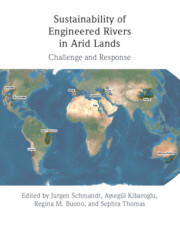19 - Conclusion
What We Found and What We Recommend
from Part V - Conclusion
Published online by Cambridge University Press: 16 September 2021
Summary
The multi-year research effort in this volume has demonstrated that (1) similar challenges are faced by all SERIDAS rivers, (2) problem recognition varies widely across basins, and (3) response strategies are not sufficiently grounded in the long-term goal of river sustainability. We recommend that river managers and stakeholders follow these guidelines: Determine the river’s dependable yield – the water supply, averaged over the period of the most severe drought experienced in the historical record. Use the dependable yield to define and implement a river management strategy that carefully balances human and ecological needs in the basin. To meet human needs, do more with less – practice water conservation. This is the best obtainable strategy for redefining and maintaining river sustainability.
Keywords
- Type
- Chapter
- Information
- Sustainability of Engineered Rivers In Arid LandsChallenge and Response, pp. 273 - 281Publisher: Cambridge University PressPrint publication year: 2021



